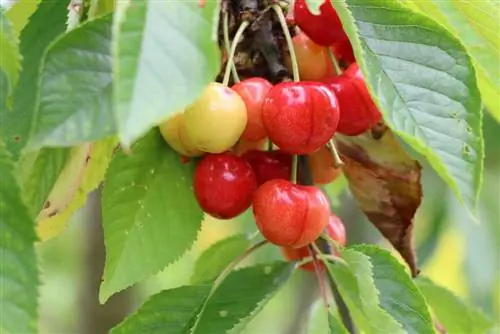- Author admin [email protected].
- Public 2023-12-17 03:39.
- Last modified 2025-06-01 06:48.
If you want to grow buckwheat in your own garden, you have to pay attention to a few special features. However, you don't have to put in a lot of effort to achieve a fairly high return. Even without the intention of harvesting, the Fagopyrum is a wonderful garden plant and, above all, a valuable source of food for bees. However, in order for it to even make it to flowering, some preparation and some care is necessary. However, due to its undemanding nature, even newbie gardeners can do this.
Location
The right location for growing buckwheat should be as sunny, warm and dry as possible. Cold winds that cool down the soil are more than unfavorable for germination. Likewise, areas where there is high groundwater or depressions where water collects when it rains.
Tip:
Because Fagopyrum is so attractive to flying insects, it should not be grown too close to the house. Otherwise there is a risk, especially for allergy sufferers.
Substrate
The optimal substrate for growing buckwheat is loose, well ventilated and crumbly. It should also be as dry as possible and not prone to compaction. Light soils are best suited, but Fagopyrum can also thrive in heavy soil.
Pre-breeding
Buckwheat tolerates cold poorly and needs quite warm soil to germinate. Pre-cultivation under glass, in the house or greenhouse can therefore make sense. However, this only applies if the Fagopyrum is to be cultivated as an ornamental plant or grown on a very small scale. Alternatively, it is advisable to use well-insulated raised beds. If these are equipped with covers, sowing can take place a little earlier. In addition, the plants are more protected here should an unexpected drop in temperature occur.
Cultivation
In preparation for growing buckwheat, the bed should be dug up the previous year and loosened well. Weeds must be removed. It is also recommended to enrich the soil with well-rotted compost. Cultivation then begins with direct sowing in spring, after the last frost. Since the seeds are damaged at temperatures below 3 °C and only germinate when the soil is at least 10 °C warm, they should be sown in May at the earliest, but preferably at the beginning of June. There should be a distance of around 40 cm to 60 cm between the rows of seeds to be prepared. However, the seeds can be sown in continuous rows. Lightly covered and moderately watered, germination occurs quite quickly. Provided the ground is warm enough. From germination, the Fagopyrum plants can be left almost to their own devices.
Pouring
Buckwheat tolerates drought well, but not wet. This already applies to germination. From the first shoots to flowering, the substrate may be slightly moist throughout. When the first buds open, watering can be restricted again. After flowering, watering only makes sense in persistently hot and rainless phases. If the plants have their leaves drooping, they can of course also be watered. However, waterlogging should never occur, which is why you should always water sparingly.
Tip:
If you spread a layer of mulch or foil between the rows, you basically don't have to worry about watering at all. However, these should not be applied to soil that is too moist.
Fertilize
If the soil was enriched with compost before starting to grow buckwheat, further fertilization is not necessary. If you forget this step, you can work some compost into the substrate until flowering. Alternatively, you can water with pond water, add coffee grounds to the water or use nettle manure. But beware. Over-fertilization can quickly lead to delayed ripening and excessive herb growth.
Fertilization
In the right location and in dry weather, Fagopyrum is a flower-rich plant. As a rule, it has so many flowers that hardly all of them can be fertilized by bees. Since pollination is carried out solely by insects, they should have free access to the plants during flowering. Any protection against game and bird damage must be removed during this time.
Harvest
It doesn't take long for buckwheat to be ready for harvest. This can begin as early as three to four months - usually in August. Ripeness can be recognized by the light brown and dry casings. However, buckwheat is a bit difficult here. The fruit clusters ripen at different times. By the time the last ones are ready to harvest, the first ones are already spreading their seeds on the ground. Therefore, there are two options. Either by hand and according to maturity or everything is harvested by scything and knocking out when around half to three quarters of the fruit clusters are ripe. The former is laborious and time-consuming, especially when Fagopyrum is grown on a large scale. And therefore hardly possible to realize. In the second variant, however, a relatively large amount of crop is lost.
Recycling
Before the buckwheat can be used, it must be peeled and ground. It is possible to send it to a mill as an order.
Alternatively, the process can be carried out yourself using a small grain mill. The resulting flour can be used, for example, as a base for porridge, patties or bread.
Typical diseases, care errors and pests
Buckwheat is extremely robust against both diseases and pests. However, if the weather is unfavorable, i.e. too humid or cool, there can be a significant reduction in yield. The same applies to an unfavorable choice of location or excessive watering. Weeds can also be dangerous for buckwheat. When preparing the bed, care should be taken to ensure that it is free of weeds. Alternatively, mulch can be applied between the rows of plants or a plant film can be laid out. These measures reduce weed pressure and also reduce effort.
Frequently asked questions
Why is the buckwheat yield so low?
Buckwheat is not one of the high-yielding plants, even under optimal cultivation conditions. However, the harvest can be further reduced if the summer is very cool or humid.
Does crop rotation have to be observed when growing Fagopyrum?
Buckwheat is very compatible with itself and can therefore easily be grown on the same area for several years. The only important thing is that the soil is fertilized and prepared accordingly.
What you should know about buckwheat in brief
Profile
- Buckwheat is not a grain. It belongs to the knotweed family and is therefore related to rhubarb.
- The first part of its name is derived from the beech tree, because the fruits of buckwheat resemble beech nuts.
- The main food cultivated is buckwheat, which has only increased in demand again in the last few decades.
- Buckwheat grows between 20 and 60 cm high and has heart-shaped leaves.
- Very long, fine hairy roots grow on its main root, with which the plants can sustain themselves well on nutrient-poor and dry soils-
- Buckwheat can also be sown as green manure; its rapid growth means it covers large areas in a very short time.
- Buckwheat is also valued by beekeepers; it can be used to produce buckwheat honey, which has a dark brown color.
Cultivation
- Buckwheat places little demands on the soil, but is very sensitive to frost, so it can only be sown from May.
- It then germinates very quickly within three to five days and only needs about three months until it bears fruit.
- In favorable locations it can therefore be sown twice in a row.
- The reddish white flowers appear from July and contain a lot of nectar that attracts insects and bees.
- They form triangular fruits with a thick peel that should not be eaten.
- Buckwheat is harvested in late summer when the fruits have turned brown.
- However, this is often a bit difficult because the little nuts are very loose and fall down quickly.
Gluten-free food
- The fact that buckwheat does not contain gluten has the disadvantage that it is not suitable for baking bread.
- On the other hand, it is also a valuable food for people who suffer from gluten intolerance.
- It is sold primarily in natural food stores, but now also in conventional supermarkets, where it is offered as peeled grain, groats or flour.
- Buckwheat contains a lot of protein and can even lower high blood sugar levels.
- What is of concern, however, is fagopyrine, a red dye contained in the fruit peel. It can lead to the so-called buckwheat disease, which can cause itchy skin rashes and other symptoms when exposed to sunlight. Consuming purchased products is harmless in this regard, but home-grown buckwheat should be peeled before use for this reason.






